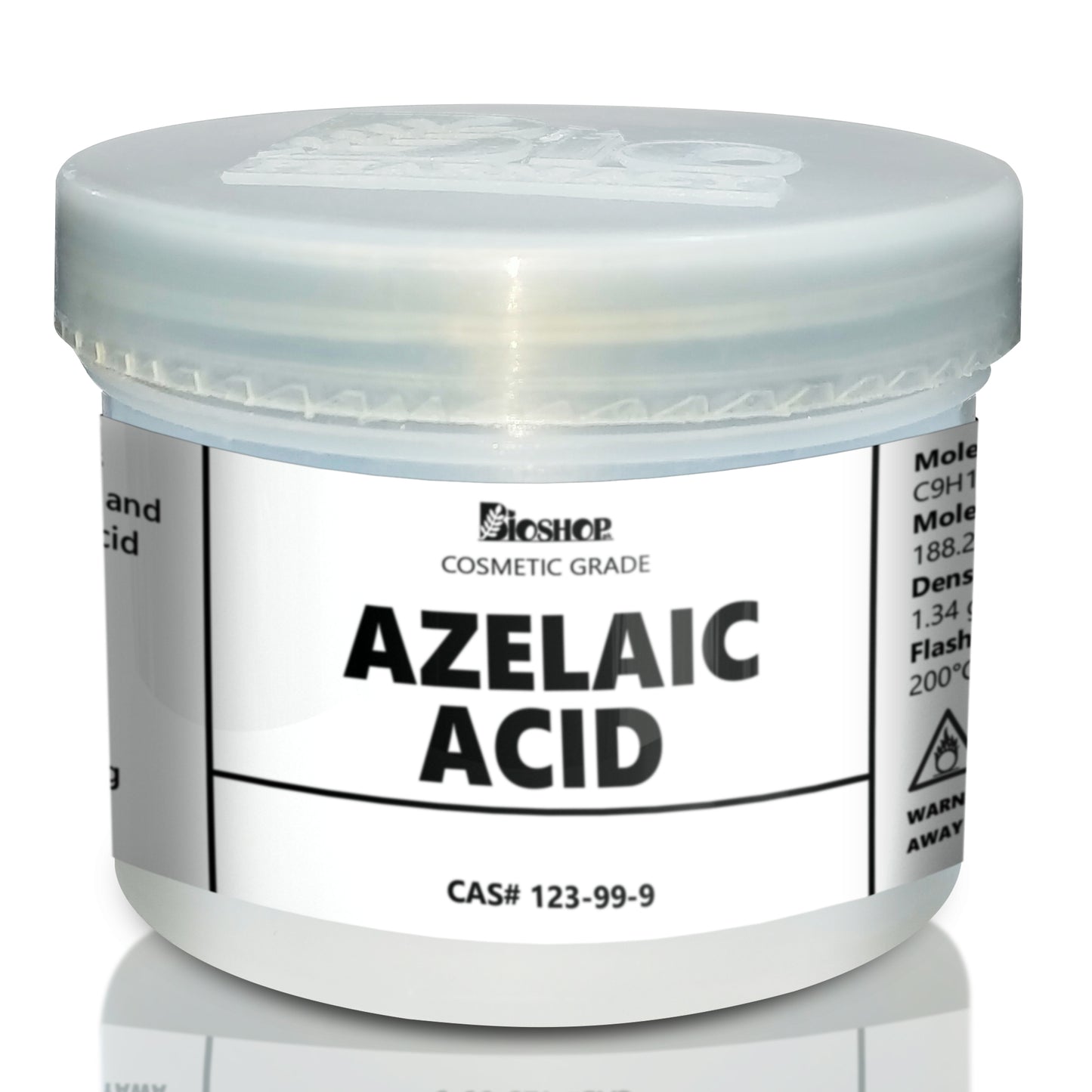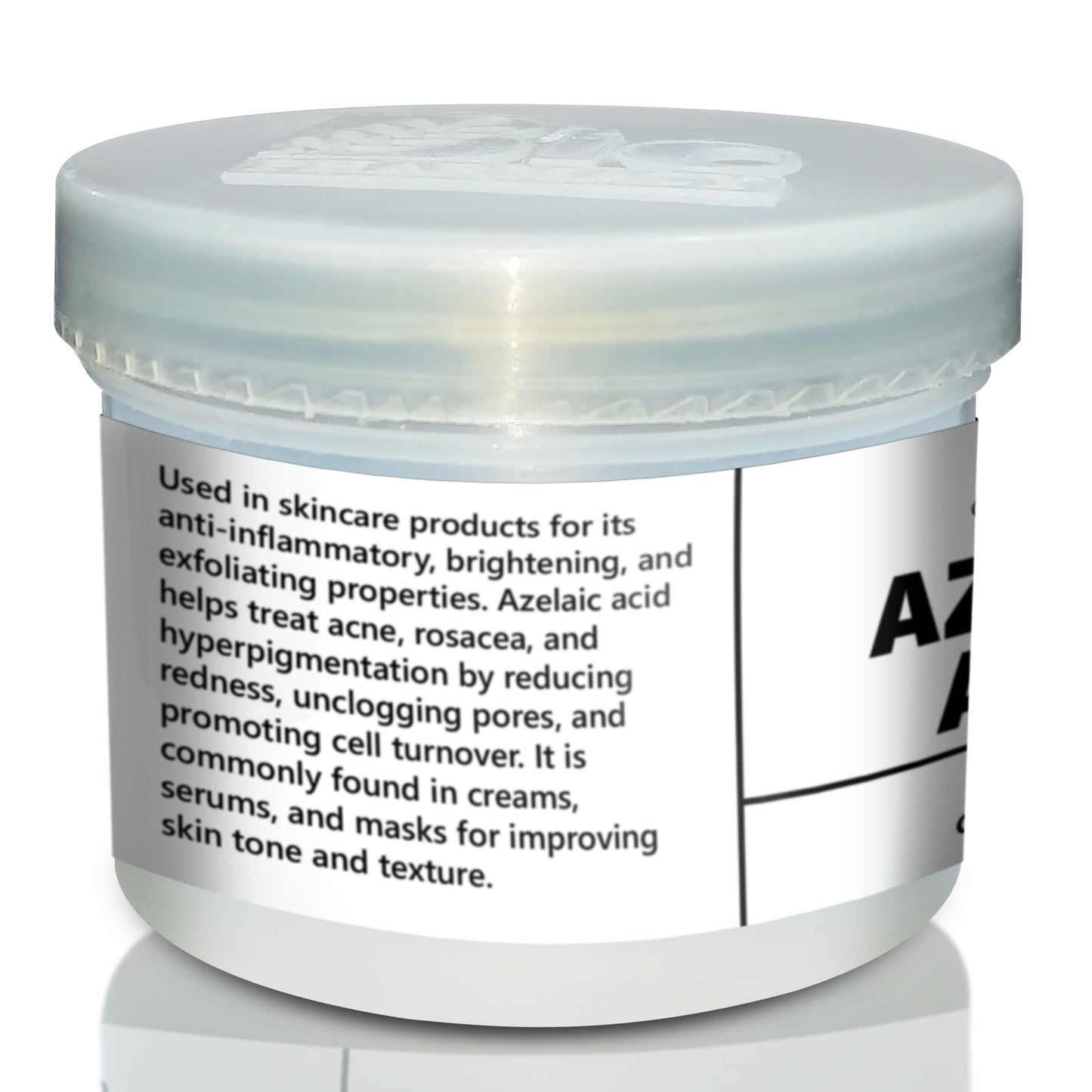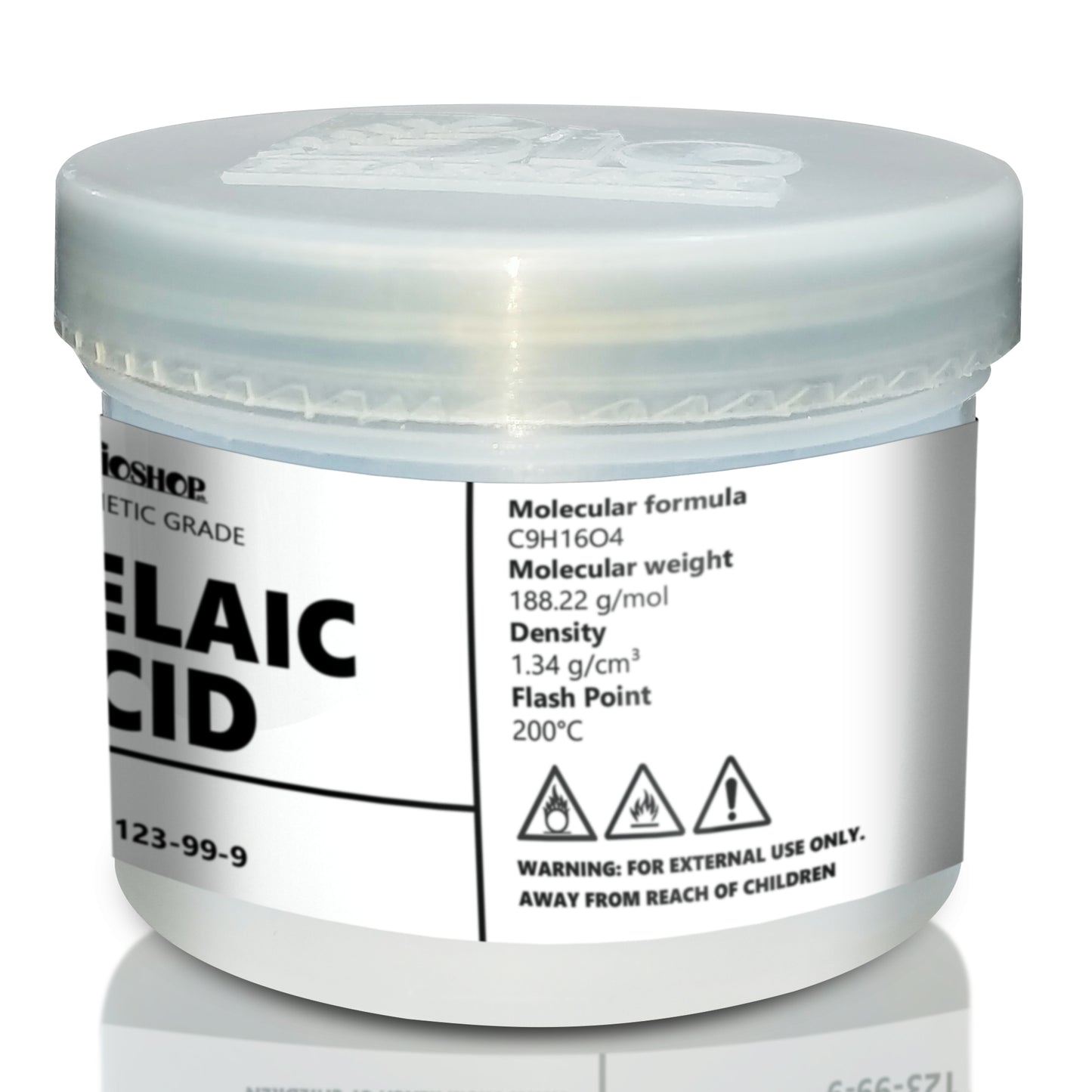Bio Shop
Azelaic Acid
Azelaic Acid
Key Functions: Acts as a multi-functional active that reduces acne, brightens skin, and calms redness in sensitive and blemish-prone skin.
Couldn't load pickup availability
Explore
Information About Azelaic Acid
✅ Key Features
- Fights acne-causing bacteria and clogged pores
- Brightens hyperpigmentation and evens skin tone
- Calms inflammation in rosacea and sensitive skin
- Suitable for long-term use and layering
- Non-comedogenic and pregnancy-safe
🔬 Description
Azelaic Acid is a naturally occurring dicarboxylic acid found in grains like wheat and barley. It is known for its powerful ability to reduce acne, treat rosacea, and brighten post-acne marks without irritating the skin. Azelaic Acid helps normalize keratinization (cell turnover), reduce bacterial overgrowth (C. acnes), and calm inflammation. It's ideal for use in leave-on serums, creams, and gel formulations — especially for acne-prone, sensitive, and dull skin types.
📊 Technical Data
INCI Name: Azelaic Acid
CAS Number: 123-99-9
Solubility: Poorly water-soluble; soluble in ethanol/glycols
Add Phase: Solubilized in water/glycol mix or pre-dissolved base
pH Stability: Stable between pH 4.0 – 6.5
Processing Temperature: Use below 45°C after solubilization
Appearance: White crystalline powder
Odor: Odorless
Molecular Weight: 188.22 g/mol
Flash Point: 158°C
Density: ~1.3 g/cm³
🧪 Recommended Usage
- Usage Rate: 1% – 10%
- Pre-dissolve in glycols or use ready-made suspensions
- Ideal for: Acne Serums, Spot Treatments, Brightening Creams, Gel Lotions
💡 Pro Tip
🌟 Create a non-irritating brightening serum with 5% Azelaic Acid, niacinamide, and panthenol in a hydrating gel base. Perfect for fading dark spots and reducing bumps without drying the skin.
👩🔬 Skin Type Compatibility
✔️ Suitable for oily, acne-prone, rosacea-sensitive, and uneven skin tone
✔️ Safe for long-term use and during pregnancy
🧴 Formulation Ideas
1. Acne Treatment Gel
Combine 10% Azelaic Acid with propanediol and allantoin in a clear base for an effective leave-on acne treatment.
2. Brightening Face Cream
Add 5% Azelaic Acid to a niacinamide-rich emulsion with shea butter and licorice extract for glow and clarity.
3. Anti-Redness Serum
Use 3% Azelaic Acid with centella extract and panthenol to reduce redness and soothe reactive skin.
4. Post-Acne Spot Treatment
Create a gel with 7% Azelaic Acid and alpha arbutin for fading hyperpigmentation and smoothing rough texture.
5. Rosacea Relief Moisturizer
Formulate a calming cream with Azelaic Acid, oat extract, and squalane to reduce bumps and visible redness.
💧 Cosmetic Suitability:
Performance rating based on stability, efficacy, and compatibility across product types.
Serums
⭐⭐⭐⭐⭐ – Excellent
🟩🟩🟩🟩🟩 – Perfect for acne, hyperpigmentation, and sensitive skin solutions.
Creams & Lotions
⭐⭐⭐⭐⭐ – Excellent
🟩🟩🟩🟩🟩 – Great for adding anti-acne and brightening effects to emulsions.
Toners
⭐⭐☆☆☆ – Fair
🟧🟧⬜⬜⬜ – Not ideal unless water-solubilized properly.
Face Masks
⭐⭐⭐⭐☆ – Good
🟩🟩🟩🟩⬜ – Excellent in cream masks for acne-prone skin.
Cleansers
⭐⭐⭐☆☆ – Moderate
🟧🟧🟧⬜⬜ – Can reduce acne in rinse-off gels, but less effective than leave-ons.
Hair Masks
⭐☆☆☆☆ – Poor
🟥⬜⬜⬜⬜ – Not commonly used in haircare.
Deodorants
⭐☆☆☆☆ – Poor
🟥⬜⬜⬜⬜ – Not applicable in deodorizing products.
Eye Creams
⭐⭐☆☆☆ – Fair
🟧🟧⬜⬜⬜ – Use with caution around delicate areas; best at low %.
Shampoos
☆☆☆☆☆ – Not Suitable
🟥⬜⬜⬜⬜ – Not relevant for hair care formulations.
Soaps
⭐☆☆☆☆ – Poor
🟥⬜⬜⬜⬜ – Not compatible with high-pH soapmaking.
Conditioners
⭐☆☆☆☆ – Poor
🟥⬜⬜⬜⬜ – Not typically used in conditioning products.
Lip Balms
☆☆☆☆☆ – Not Suitable
🟥⬜⬜⬜⬜ – Not safe for lip area use.
Body Butters
⭐⭐☆☆☆ – Fair
🟧🟧⬜⬜⬜ – Useful in emulsified body creams for body acne.
❓ FAQs
Q1: Is Azelaic Acid safe for sensitive skin?
A1: Yes, it’s one of the few actives that treats acne and rosacea gently. Start at 5% and patch test if unsure.
Q2: Can I use it with Niacinamide or Vitamin C?
A2: Yes. It pairs beautifully with Niacinamide. For Vitamin C, space out usage or layer gently to avoid irritation.
Q3: Does Azelaic Acid lighten skin?
A3: It does not bleach skin, but it fades hyperpigmentation and evens out skin tone over time.
Q4: Is it pregnancy-safe?
A4: Yes, it is often recommended by dermatologists during pregnancy for acne and melasma treatment.
Q5: How long before I see results?
A5: With consistent use, visible improvement can occur in 4–8 weeks for acne and pigmentation.
📂 Documentation
Upon request, we will provide.
Where Can You Safely Use Azelaic Acid
Discover how Azelaic Acid performs across different products — rated for safety, stability, and effectiveness.







